Au-Based Bimetallic Catalysts for Aerobic Oxidation of 5-Hydroxymethylfurfural to 2,5-Furandicarboxylic Acid under Base-Free Reaction Conditions
Abstract
:1. Introduction
2. Results
2.1. Characterization of the Catalysts
2.2. Catalytic Performances of HMF Oxidation to FDCA
2.3. Insight into Improvements to Au-M Bimetallic Catalysts for HMF Oxidation to FDCA
3. Materials and Method
3.1. Materials
3.2. Preparation of the Catalysts
3.2.1. Preparation of the Au NCs and Au-M Bimetallic NCs
3.2.2. Preparation of MgAl-Hydrotalcite (HT)
3.2.3. Preparation of the Supported Au and Au-M Bimetallic Catalysts
3.3. Catalytic Evaluation of HMF Oxidation
3.4. Characterization
4. Conclusions
Supplementary Materials
Author Contributions
Funding
Institutional Review Board Statement
Informed Consent Statement
Data Availability Statement
Acknowledgments
Conflicts of Interest
References
- Zhang, T. Taking on all of the biomass for conversion. Science 2020, 376, 1305–1306. [Google Scholar] [CrossRef] [PubMed]
- He, L.; Chen, L.; Zheng, B.; Zhou, H.; Wang, H.; Li, H.; Zhang, H.; Xu, C.C.; Yang, S. Deep eutectic solvents for catalytic biodiesel production from liquid biomass and upgrading of solid biomass into 5-hydroxymethylfurfural. Green Chem. 2023, 25, 7410–7440. [Google Scholar] [CrossRef]
- Ma, L.; Sels, B.F. Catalytic technologies for renewable biomass conversion. Adv. Sustain. Syst. 2020, 4, 2000171. [Google Scholar] [CrossRef]
- Li, C.; Zhao, X.; Wang, A.; Huber, G.W.; Zhang, T. Catalytic transformation of lignin for the production of chemicals and fuels. Chem. Rev. 2015, 115, 11559–11624. [Google Scholar] [CrossRef] [PubMed]
- Deng, W.; Feng, Y.; Fu, J.; Guo, H.; Guo, Y.; Han, B.; Jiang, Z.; Kong, L.; Li, C.; Liu, H.; et al. Catalytic conversion of lignocellulosic biomass into chemicals and fuels. Green Energy Environ. 2023, 8, 10–114. [Google Scholar] [CrossRef]
- Turkin, A.A.; Makshina, E.V.; Sels, B.F. Catalytic hydroconversion of 5-HMF to value-added chemicals: Insights into the role of catalyst properties and feedstock purity. ChemSusChem 2022, 15, e202200412. [Google Scholar] [CrossRef] [PubMed]
- Cai, X.; Wang, Z.; Ye, Y.; Wang, D.; Zhang, Z.; Zheng, Z.; Liu, Y.; Li, S. Conversion of chitin biomass into 5-hydroxymethylfurfural: A review. Renew. Sustain. Energy Rev. 2021, 150, 111452. [Google Scholar] [CrossRef]
- Shapla, U.M.; Solayman, M.; Alam, N.; Khalil, M.I.; Gan, S.H. 5-Hydroxymethylfurfural (HMF) levels in honey and other food products: Effects on bees and human health. Chem. Cent. J. 2018, 12, 35. [Google Scholar] [CrossRef] [PubMed]
- Wang, H.; Zhu, C.; Li, D.; Liu, Q.; Tan, J.; Wang, C.; Cai, C.; Ma, L. Recent advances in catalytic conversion of biomass to 5-hydroxymethylfurfural and 2, 5-dimethylfuran. Renew. Sustain. Energy Rev. 2019, 103, 227–247. [Google Scholar] [CrossRef]
- Arias, K.S.; Climent, M.J.; Corma, A.; Iborra, S. Biomass-derived chemicals: Synthesis of biodegradable surfactant ether molecules from hydroxymethylfurfural. ChemSusChem 2013, 7, 210–220. [Google Scholar] [CrossRef]
- Corma, A.; Casanova, O.; Iborra, S. Biomass into chemicals: One pot-base free oxidative esterification of 5-hydroxymethyl-2-furfural into 2,5-dimethylfuroate with gold on nanoparticulated ceria. J. Catal. 2009, 265, 109–116. [Google Scholar]
- Zhong, X.; Yuan, P.; Wei, Y.; Liu, D.; Losic, D.; Li, M. Coupling natural halloysite nanotubes and bimetallic Pt–Au alloy nanoparticles for highly efficient and selective oxidation of 5-hydroxymethylfurfural to 2,5-furandicarboxylic acid. ACS Appl. Mater. Interfaces 2022, 14, 3949–3960. [Google Scholar] [CrossRef] [PubMed]
- Ait Rass, H.; Essayem, N.; Besson, M. Selective aqueous phase oxidation of 5-hydroxymethylfurfural to 2,5-furandicarboxylic acid over Pt/C catalysts: Influence of the base and effect of bismuth promotion. Green Chem. 2013, 15, 2240–2251. [Google Scholar] [CrossRef]
- Zhang, Z.; Zhen, J.; Liu, B.; Lv, K.; Deng, K. Selective aerobic oxidation of the biomass-derived precursor 5-hydroxymethylfurfural to 2, 5-furandicarboxylic acid under mild conditions over a magnetic palladium nanocatalyst. Green Chem. 2015, 17, 1308–1317. [Google Scholar] [CrossRef]
- Lolli, S.; Albonetti, L.; Utili, R.; Amadori, F.; Ospitali, C.; Lucarelli, F. Insights into the reaction mechanism for 5-hydroxymethylfurfural oxidation to FDCA on bimetallic Pd-Au nanoparticles. Appl. Catal. A 2015, 504, 408–419. [Google Scholar] [CrossRef]
- Gorbanev, Y.; Kegnæs, S.; Riisager, A. Selective aerobic oxidation of 5-hydroxymethylfurfural in water over solid ruthenium hydroxide catalysts with magnesium-based supports. Catal. Lett. 2011, 141, 1752–1760. [Google Scholar] [CrossRef]
- Gorbanev, Y.; Kegnæs, S.; Riisager, A. Effect of support in heterogeneous ruthenium catalysts used for the selective aerobic oxidation of HMF in water. Top. Catal. 2011, 54, 1318–1324. [Google Scholar] [CrossRef]
- Rabee, A.; Le, S.D.; Higashimine, K.; Nishimura, S. Aerobic Oxidation of 5-Hydroxymethylfurfural into 2,5-Furandicarboxylic Acid over Gold Stabilized on Zirconia-Based Supports. ACS Sustain. Chem. Eng. 2020, 8, 7150–7161. [Google Scholar] [CrossRef]
- Chen, L.; Zhuang, W.; Lan, J.; Liu, X.; Jiang, S.; Wang, L.; Zhou, Y.; Wang, J. Base-free atmospheric O2-mediated oxidation of 5-hydroxymethylfurfural to 2,5-furandicarboxylic acid triggered by Mg-bearing MTW zeolite supported Au nanoparticles. Appl. Catal. A 2021, 616, 118106. [Google Scholar] [CrossRef]
- Cai, J.; Ma, H.; Zhang, J.; Song, Q.; Du, Z.; Huang, Y.; Xu, J. Gold Nanoclusters Confined in a Supercage of Y Zeolite for Aerobic Oxidation of HMF under Mild Conditions. Chem. Eur. J. 2013, 19, 14215–14223. [Google Scholar] [CrossRef] [PubMed]
- Masoud, N.; Donoeva, B.; Jongh, P.E. Stability of gold nanocatalysts supported on mesoporous silica for the oxidation of 5-hydroxymethyl furfural to furan-2,5-dicarboxylic acid. Appl. Catal. A-Gen. 2018, 561, 150–157. [Google Scholar] [CrossRef]
- Cai, J.; Li, K.; Wu, S. Recent advances in catalytic conversion of biomass derived 5-hydroxymethylfurfural into 2,5-furandicarboxylic acid. Biomass Bioenerg. 2022, 158, 106358. [Google Scholar] [CrossRef]
- Donoeva, B.; Masoud, N.; Jongh, P.E. Carbon Support Surface Effects in the Gold-Catalyzed Oxidation of 5-Hydroxymethylfurfural. ACS Catal. 2017, 7, 4581–4591. [Google Scholar] [CrossRef] [PubMed]
- Wan, X.; Zhou, C.; Chen, J.; Deng, W.; Zhang, Q.; Yang, Y.; Wang, Y. Base-Free Aerobic Oxidation of 5-Hydroxymethyl-furfural to 2,5-Furandicarboxylic Acid in Water Catalyzed by Functionalized Carbon Nanotube-Supported Au−Pd Alloy Nanoparticles. ACS Catal. 2014, 4, 2175–2185. [Google Scholar] [CrossRef]
- Sajid, M.; Zhao, X.; Liu, D. Production of 2,5-furandicarboxylic acid (FDCA) from 5-hydroxymethylfurfural (HMF): Recent progress focusing on the chemical-catalytic routes. Green Chem. 2018, 20, 5427–5453. [Google Scholar] [CrossRef]
- Zanella, R.; Louis, C. Influence of the conditions of thermal treatments and of storage on the size of the gold particles in Au/TiO2 samples. Catal. Today 2005, 107–108, 768–777. [Google Scholar]
- Li, G.; Jin, R. Atomically precise gold nanoclusters as new model catalysts. Acc. Chem. Res. 2013, 46, 1749–1758. [Google Scholar] [CrossRef]
- Jin, R. Atomically precise metal nanoclusters: Stable sizes and optical properties. Nanoscale 2015, 7, 1549–1565. [Google Scholar] [CrossRef] [PubMed]
- Guan, Z.J.; Li, J.J.; Hu, F.; Wang, Q.M. Structural engineering toward gold nanocluster catalysis. Angew. Chem. Int. Ed. 2022, 61, e202209725. [Google Scholar] [CrossRef] [PubMed]
- Tang, Q.; Hu, G.; Fung, V.; Jiang, D.E. Insights into interfaces, stability, electronic properties, and catalytic activities of atomically precise metal nanoclusters from first principles. Acc. Chem. Res. 2018, 51, 2793–2802. [Google Scholar] [CrossRef] [PubMed]
- Masuda, S.; Tsukuda, T. Partially thiolated Aun (n = 25, 102) clusters on layered double hydroxides anchored by electrostatic interactions: Size effect on 5-hydroxymethylfurfural oxidation catalysis. ACS Catal. 2023, 13, 16179–16187. [Google Scholar] [CrossRef]
- Sakamoto, K.; Masuda, S.; Takano, S.; Tsukuda, T. Partially thiolated Au25 cluster anchored on carbon support via noncovalent ligand–support interactions: Active and robust catalyst for aerobic oxidation of alcohols. ACS Catal. 2023, 13, 3263–3271. [Google Scholar] [CrossRef]
- Zheng, K.; Setyawati, M.I.; Leong, D.T.; Xie, J. Antimicrobial gold nanoclusters. ACS Nano 2017, 11, 6904–6910. [Google Scholar] [CrossRef] [PubMed]
- Ghosh, A.; Mohammed, O.F.; Bakr, O.M. Atomic-level doping of metal clusters. Acc. Chem. Res. 2018, 51, 3094–3103. [Google Scholar] [CrossRef] [PubMed]
- Gao, Y.C.; Wang, C.; Zhang, C.X.; Li, H.W.; Wu, Y. Controlled preparation and application of glutathione capped gold and platinum alloy nanoclusters with high peroxidase-like activity. J. Mater. Sci. Technol. 2022, 109, 140–146. [Google Scholar] [CrossRef]
- Lv, G.; Zhang, Z.; Liu, S.; Tao, F.; Wang, J.; Meng, Y.; Yang, Y. Atom level revelation of the synergistic effect between Pd and Au atoms in PdAu nanoalloy catalyst for aerobic oxidation of 5-hydroxymethylfurfural. Chem. Eng. J. 2023, 453, 139816. [Google Scholar] [CrossRef]
- Xie, S.; Tsunoyama, H.; Kurashige, W.; Negishi, Y.; Tsukuda, T. Enhancement in aerobic alcohol oxidation catalysis of Au25 clusters by single Pd atom doping. ACS Catal. 2012, 2, 1519–1523. [Google Scholar] [CrossRef]
- Gao, A.; Liu, H.; Hu, L.; Zhang, H.; Hou, A.; Xie, K. Synthesis of Fe3O4@SiO2-Au/Cu magnetic nanoparticles and its efficient catalytic performance for the Ullmann coupling reaction of bromamine acid. Chin. Chem. Lett. 2018, 29, 1301–1304. [Google Scholar] [CrossRef]
- Mukherjee, S.; Das, A.; Das, A.K.; Sheriff, A.; Sunny, K.; Nair, A.S.; Bhandary, S.; Bhowal, R.; Chopra, D.; Pathak, B.; et al. Single Cu atom doping on Au11 nanocluster: Its implication toward selectivity in C–C coupling reaction. Chem. Mater. 2023, 35, 1659–1666. [Google Scholar] [CrossRef]
- Liu, Z.; Tan, Y.; Li, J.; Li, X.; Xiao, Y.; Su, J.; Chen, X.; Qiao, B.; Ding, Y. Ag substituted Au clusters supported on Mg-Al-hydrotalcite for highly efficient base-free aerobic oxidation of 5-hydroxymethylfurfural to 2,5-furandicarboxylic acid. Green Chem. 2022, 24, 8840–8852. [Google Scholar] [CrossRef]
- Yuan, Q.; Hiemstra, K.; Meinds, T.G.; Chaabane, I.; Tang, Z.; Rohrbach, L.; Vrijburg, W.; Verhoeven, T.; Hensen, E.J.M.; van der Veer, S.; et al. Bio-based chemicals: Selective aerobic oxidation of tetrahydrofuran-2,5-dimethanol to tetrahydrofuran-2,5-dicarboxylic acid using hydrotalcite-supported gold catalysts. ACS Sustain. Chem. Eng. 2019, 7, 4647–4656. [Google Scholar] [CrossRef]
- Gupta, D.; Kumar, R.; Pant, K.K. Hydrotalcite supported bimetallic (Ni-Cu) catalyst: A smart choice for one-pot conversion of biomass-derived platform chemicals to hydrogenated biofuels. Fuel 2020, 277, 118111. [Google Scholar] [CrossRef]
- Yuan, X.; Zhang, B.; Luo, Z.; Yao, Q.; Leong, D.T.; Yan, N.; Xie, J. Balancing the rate of cluster growth and etching for gram-scale synthesis of thiolate-Protected Au25 nanoclusters with atomic precision. Angew. Chem. 2014, 53, 4623–4627. [Google Scholar] [CrossRef] [PubMed]
- Wang, S.; Song, Y.; Jin, S.; Liu, X.; Zhang, J.; Pei, Y.; Meng, X.; Chen, M.; Li, P.; Zhu, M. Metal exchange method using Au25 nanoclusters as templates for alloy nanoclusters with atomic precision. J. Am. Chem. Soc. 2015, 137, 4018–4021. [Google Scholar] [CrossRef] [PubMed]
- Liu, P.; Guan, Y.; Santen, R.A.v.; Li, C.; Hensen, E.J.M. Aerobic oxidation of alcohols over hydrotalcite-supported gold nanoparticles: The promotional effect of transition metal cations. Chem. Commun. 2011, 47, 11540–11542. [Google Scholar] [CrossRef] [PubMed]
- Gao, Z.; Xie, R.; Fan, G.; Yang, L.; Li, F. Highly efficient and stable bimetallic AuPd over La-doped Ca–Mg–Al layered double hydroxide for base-free aerobic oxidation of 5-hydroxymethylfurfural in water. ACS Sustain. Chem. Eng. 2017, 5, 5852–5861. [Google Scholar] [CrossRef]
- Liu, P.; Degirmenci, V.; Hensen, E.J.M. Unraveling the synergy between gold nanoparticles and chromium-hydrotalcites in aerobic oxidation of alcohols. J. Catal. 2014, 313, 80–91. [Google Scholar] [CrossRef]
- Romero Ortiz, G.; Lartundo-Rojas, L.; Samaniego-Benitez, J.E.; Jimenez-Flores, Y.; Calderon, H.A.; Mantilla, A. Photocatalytic behavior for the phenol degradation of ZnAl layered double hydroxide functionalized with SDS. J. Environ. Manag. 2021, 277, 111399. [Google Scholar] [CrossRef] [PubMed]
- Tan, Y.; Liu, X.Y.; Zhang, L.; Wang, A.; Li, L.; Pan, X.; Miao, S.; Haruta, M.; Wei, H.; Wang, H.; et al. ZnAl-hydrotalcite-supported Au25 nanoclusters as precatalysts for chemoselective hydrogenation of 3-nitrostyrene. Angew. Chem. Int. Ed. 2017, 56, 2709–2713. [Google Scholar] [CrossRef]
- Ampelli, C.; Barbera, K.; Centi, G.; Genovese, C.; Papanikolaou, G.; Perathoner, S.; Schouten, K.J.; van der Waal, J.K. On the nature of the active sites in the selective oxidative esterification of furfural on Au/ZrO2 catalysts. Catal. Today 2016, 278, 56–65. [Google Scholar] [CrossRef]
- Wang, Z.; Feng, J.; Li, X.; Oh, R.; Shi, D.; Akdim, O.; Xia, M.; Zhao, L.; Huang, X.; Zhang, G. Au-Pd nanoparticles immobilized on TiO2 nanosheet as an active and durable catalyst for solvent-free selective oxidation of benzyl alcohol. J. Colloid Interface Sci. 2021, 588, 787–794. [Google Scholar] [CrossRef] [PubMed]
- Sun, K.; Shi, Y.; Li, H.; Shan, J.; Sun, C.; Wu, Z.Y.; Ji, Y.; Wang, Z. Efficient CO2 electroreduction via Au-complex derived carbon nanotube supported Au nanoclusters. ChemSusChem 2021, 14, 4929–4935. [Google Scholar] [CrossRef] [PubMed]
- Tan, Y.; Li, X.C.; Liu, X.Y. Chemoselective hydrogenation of 3-nitrostyrene over supported gold catalysts: Effect of loadings of gold. J. Chin. Chem. Soc. 2021, 68, 444–450. [Google Scholar] [CrossRef]
- Xu, Y.; Li, J.; Zhou, J.; Liu, Y.; Wei, Z.; Zhang, H. Layered double hydroxides supported atomically precise Aun nanoclusters for air oxidation of benzyl alcohol: Effects of size and active site structure. J. Catal. 2020, 389, 409–420. [Google Scholar] [CrossRef]
- Wei, S.; Wang, W.W.; Fu, X.P.; Li, S.Q.; Jia, C.J. The effect of reactants adsorption and products desorption for Au/TiO2 in catalyzing CO oxidation. J. Catal. 2019, 376, 134–145. [Google Scholar] [CrossRef]
- Müslehiddinŏglu, J.; Vannice, M.A. CO adsorption on supported and promoted Ag epoxidation catalysts. J. Catal. 2003, 213, 305–320. [Google Scholar] [CrossRef]
- Zhang, H.; Watanabe, T.; Okumura, M.; Haruta, M.; Toshima, N. Catalytically highly active top gold atom on palladium nanocluster. Nat. Mater. 2012, 11, 49–52. [Google Scholar] [CrossRef] [PubMed]
- Wei, Y.; Zhang, Y.; Chen, Y.; Wang, F.; Cao, Y.; Guan, W.; Li, X. Crystal faces-tailored oxygen vacancy in Au/CeO2 catalysts for efficient oxidation of HMF to FDCA. ChemSusChem 2022, 15, e202101983. [Google Scholar] [CrossRef] [PubMed]
- Bonincontro, D.; Lolli, A.; Villa, A.; Prati, L.; Dimitratos, N.; Veith, G.M.; Chinchilla, L.E.; Botton, G.A.; Cavani, F.; Albonetti, S. AuPd-nNiO as an effective catalyst for the base-free oxidation of HMF under mild reaction conditions. Green Chem. 2019, 21, 4090–4099. [Google Scholar] [CrossRef]




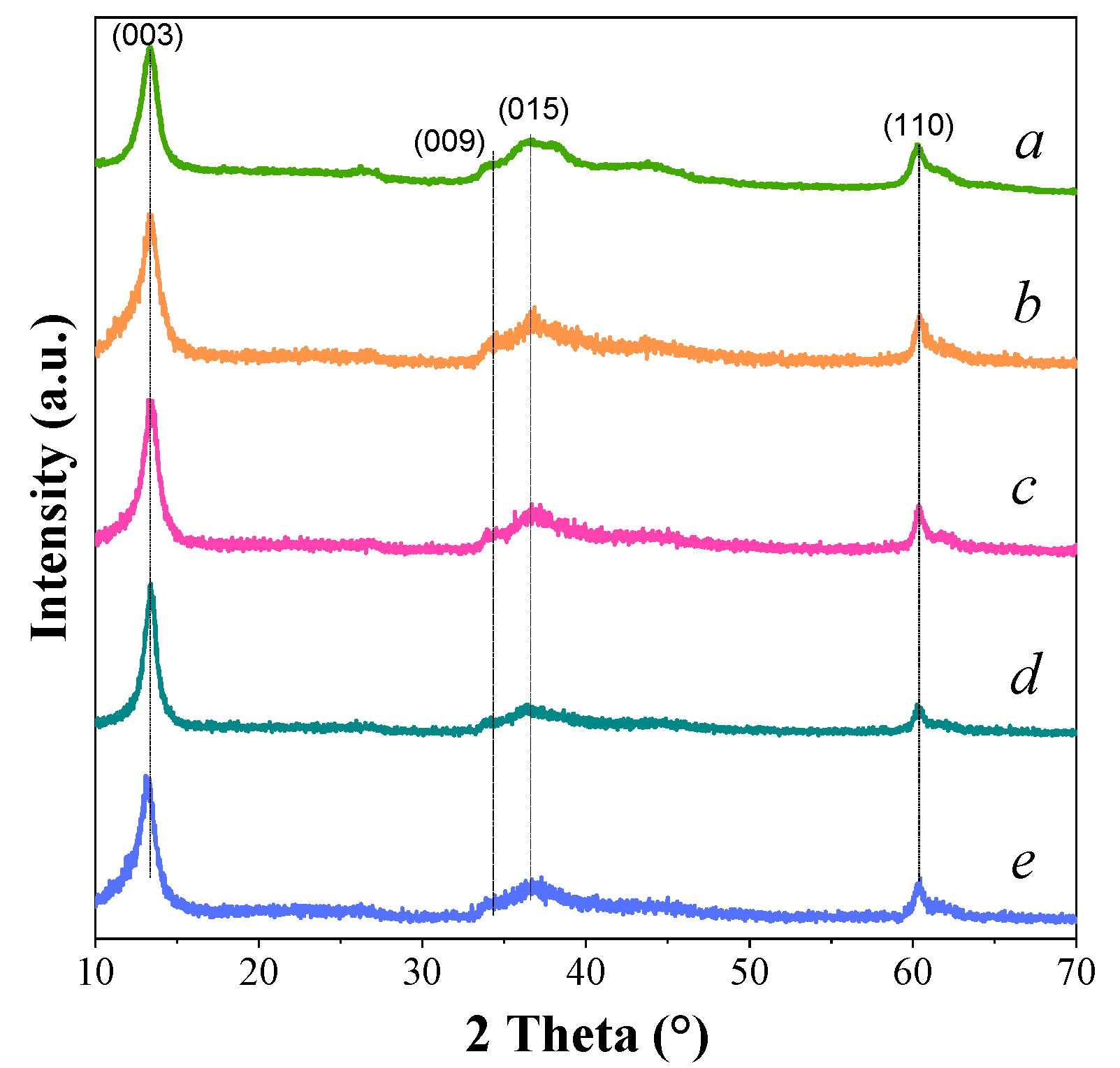
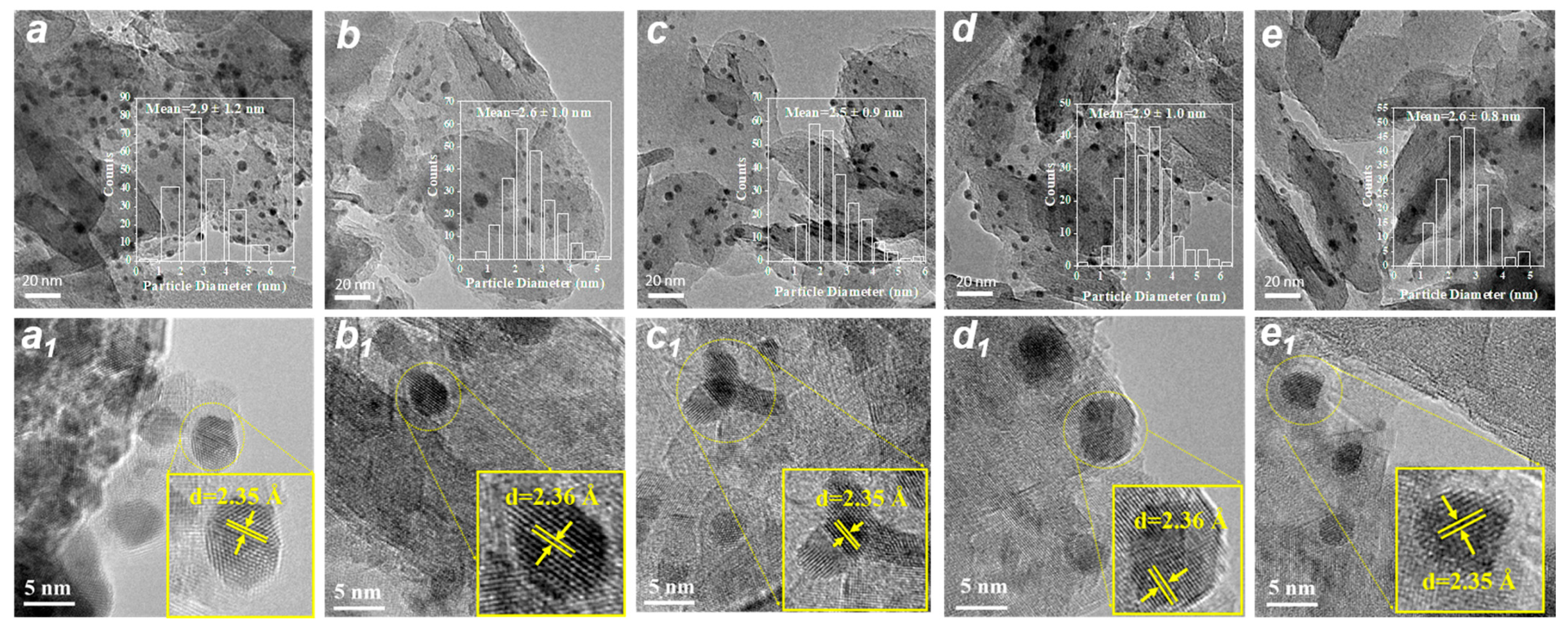
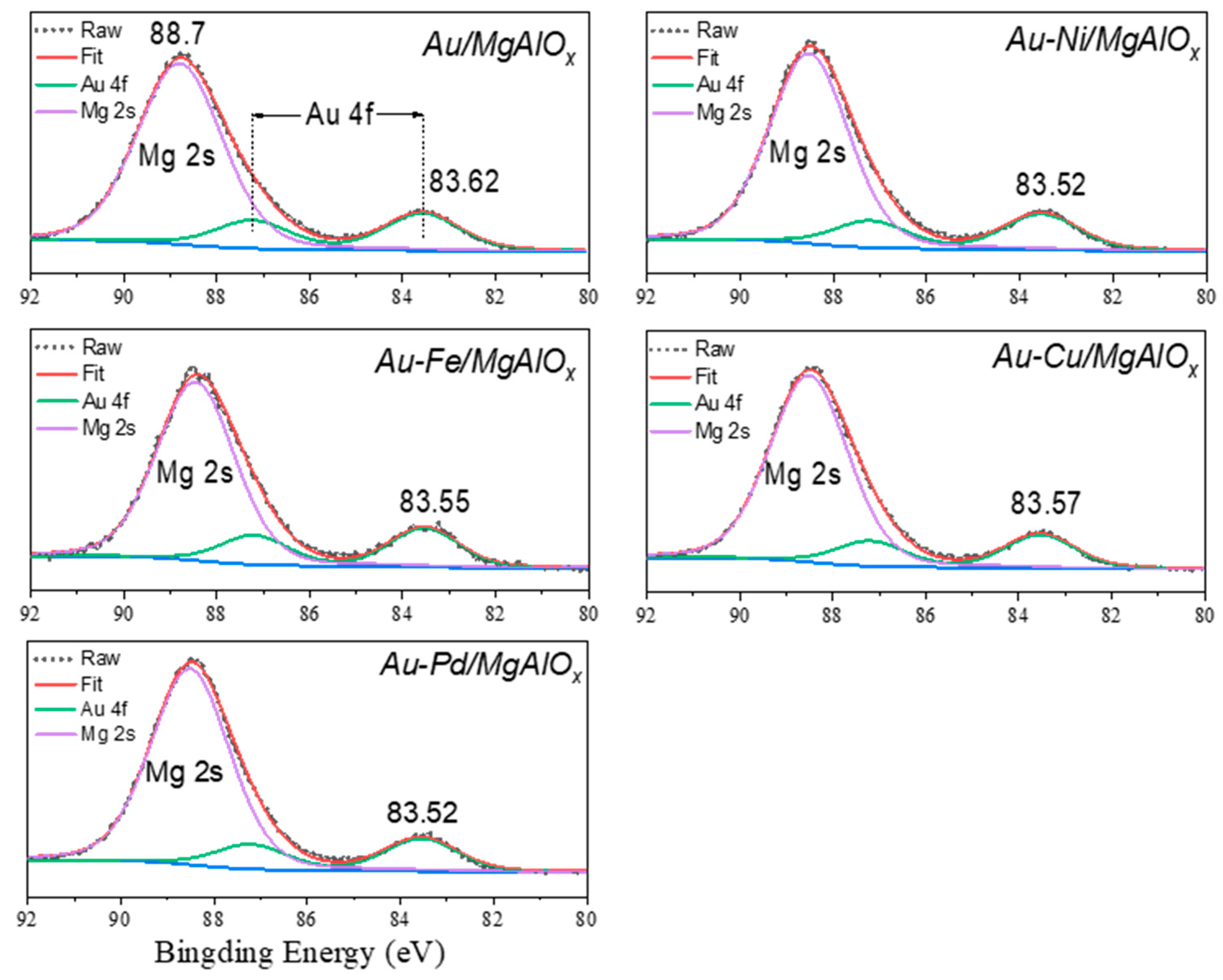
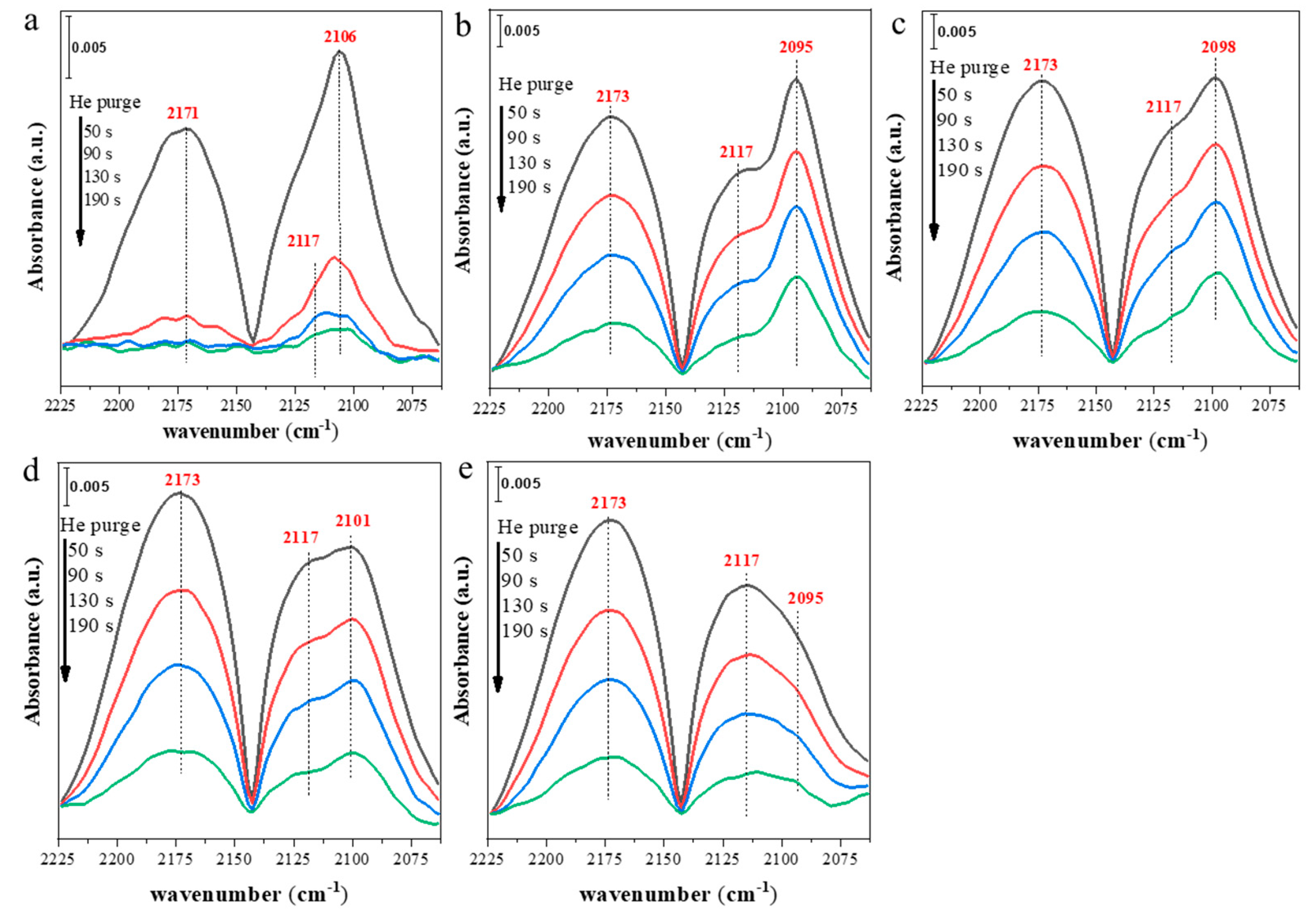

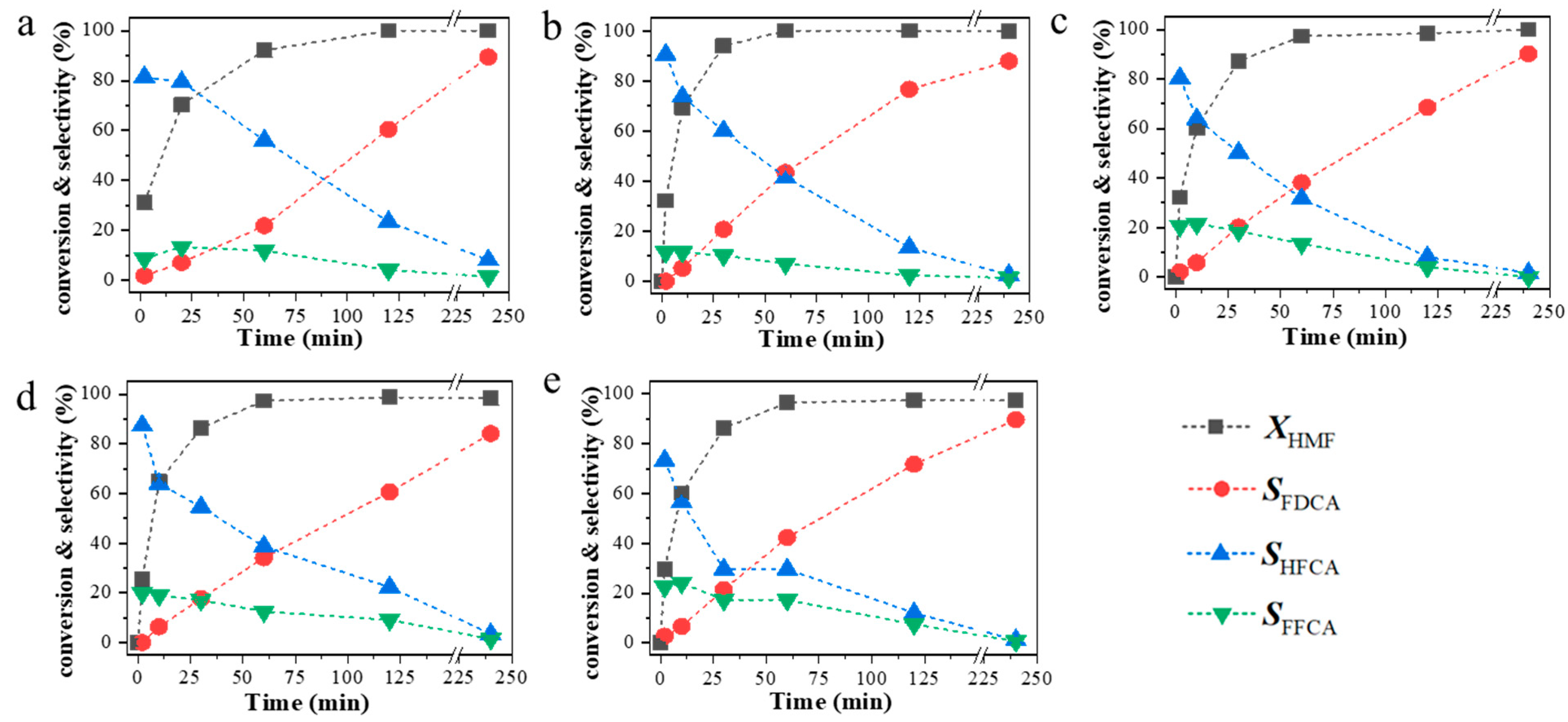
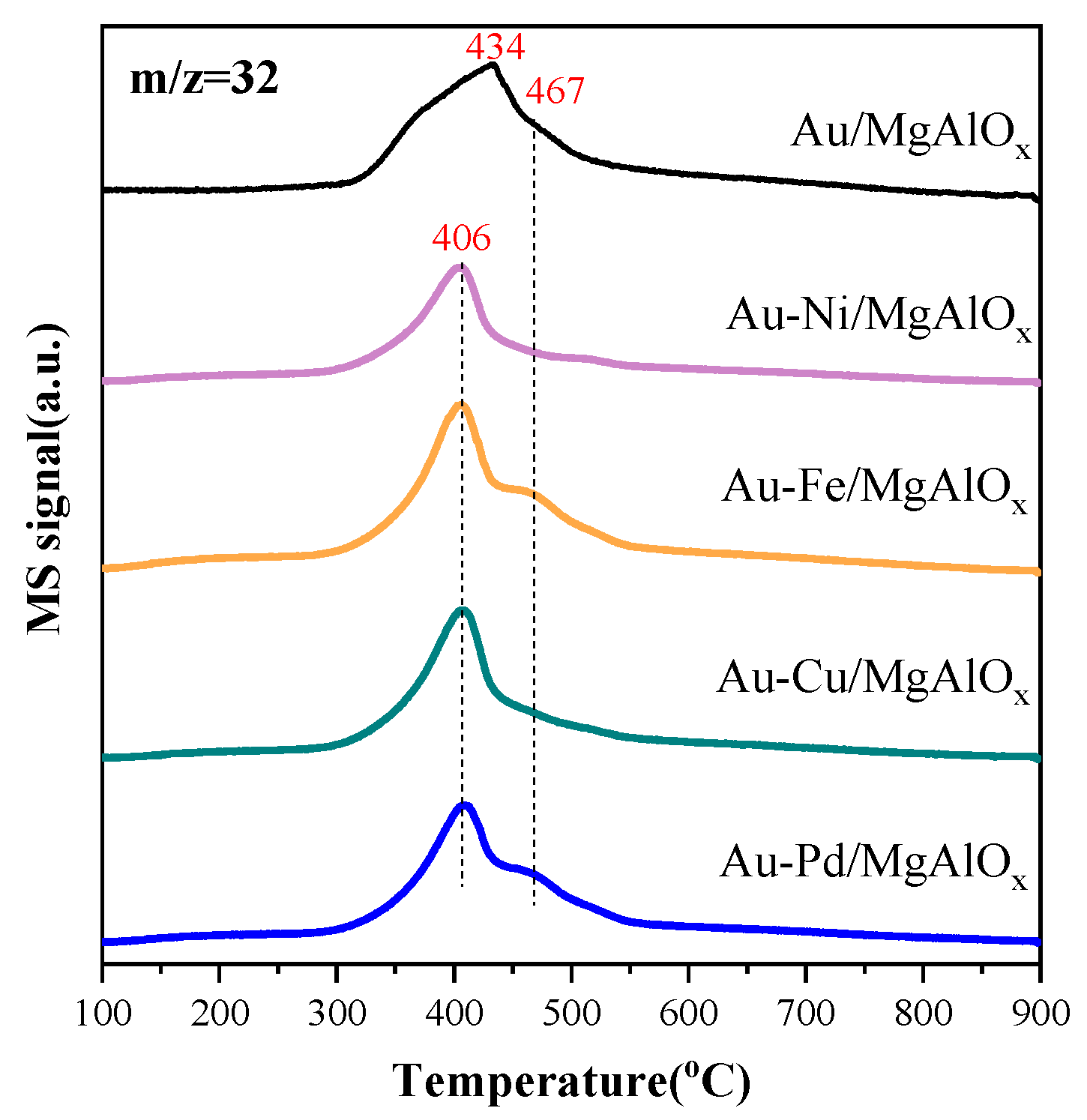
| Entry | Catalysts | Au Loading (%) a | M Loading (%) a | Au/M Molar Ratio | SBET (m2/g) b | Total Volume (m3/g) b | Pore Size (nm) b |
|---|---|---|---|---|---|---|---|
| 1 | MgAlOx | - | - | - | 79.5 | 0.33 | 9.05 |
| 2 | Au/MgAlOx | 1.10 | - | - | 71.5 | 0.32 | 9.70 |
| 3 | Au-Ni/MgAlOx | 1.09 | 0.018 | 18 | 79.5 | 0.35 | 9.07 |
| 4 | Au-Fe/MgAlOx | 1.06 | 0.020 | 15 | 89.0 | 0.39 | 9.01 |
| 5 | Au-Cu/MgAlOx | 1.07 | 0.022 | 14 | 82.6 | 0.37 | 9.03 |
| 6 | Au-Pd/MgAlOx | 1.08 | 0.031 | 19 | 77.9 | 0.34 | 9.09 |
| Entry | Catalysts | Conversion (%) | Selectivity (%) | ||
|---|---|---|---|---|---|
| FDCA | HFCA | FFCA | |||
| 1 | Au/MgAlOx | 100 | 60.5 | 23.5 | 4.2 |
| 2 | Au-Ni/MgAlOx | 100 | 76.6 | 13.5 | 2.9 |
| 3 | Au-Fe/MgAlOx | 98.5 | 68.5 | 8.1 | 4.1 |
| 4 | Au-Cu/MgAlOx | 98.8 | 60.6 | 22.3 | 9.1 |
| 5 | Au-Pd/MgAlOx | 97.6 | 71.7 | 12 | 7.5 |
| 6 | MgAlOx | 2.5 | 0 | 0 | 0 |
| 7 | Blank | 0 | 0 | 0 | 0 |
| Entry | Catalysts | TOF (h−1) a | |||
|---|---|---|---|---|---|
| HMF Oxidation | Dff Oxidation | HFCA Oxidation | FFCA Oxidation | ||
| 1 | Au/MgAlOx | 740.7 | Very fast | 72.9 | 529.9 |
| 2 | Au-Ni/MgAlOx | 758.8 | Very fast | 293.1 | 671.4 |
| 3 | Au-Fe/MgAlOx | 760.5 | Very fast | 177.5 | 704.3 |
| 4 | Au-Cu/MgAlOx | 605.0 | Very fast | 158.2 | 675.4 |
| 5 | Au-Pd/MgAlOx | 702.1 | Very fast | 227.2 | 883.9 |
Disclaimer/Publisher’s Note: The statements, opinions and data contained in all publications are solely those of the individual author(s) and contributor(s) and not of MDPI and/or the editor(s). MDPI and/or the editor(s) disclaim responsibility for any injury to people or property resulting from any ideas, methods, instructions or products referred to in the content. |
© 2024 by the authors. Licensee MDPI, Basel, Switzerland. This article is an open access article distributed under the terms and conditions of the Creative Commons Attribution (CC BY) license (https://creativecommons.org/licenses/by/4.0/).
Share and Cite
Su, J.; Liu, Z.; Tan, Y.; Xiao, Y.; Zhan, N.; Ding, Y. Au-Based Bimetallic Catalysts for Aerobic Oxidation of 5-Hydroxymethylfurfural to 2,5-Furandicarboxylic Acid under Base-Free Reaction Conditions. Molecules 2024, 29, 2724. https://doi.org/10.3390/molecules29122724
Su J, Liu Z, Tan Y, Xiao Y, Zhan N, Ding Y. Au-Based Bimetallic Catalysts for Aerobic Oxidation of 5-Hydroxymethylfurfural to 2,5-Furandicarboxylic Acid under Base-Free Reaction Conditions. Molecules. 2024; 29(12):2724. https://doi.org/10.3390/molecules29122724
Chicago/Turabian StyleSu, Juan, Zongyang Liu, Yuan Tan, Yan Xiao, Nannan Zhan, and Yunjie Ding. 2024. "Au-Based Bimetallic Catalysts for Aerobic Oxidation of 5-Hydroxymethylfurfural to 2,5-Furandicarboxylic Acid under Base-Free Reaction Conditions" Molecules 29, no. 12: 2724. https://doi.org/10.3390/molecules29122724
APA StyleSu, J., Liu, Z., Tan, Y., Xiao, Y., Zhan, N., & Ding, Y. (2024). Au-Based Bimetallic Catalysts for Aerobic Oxidation of 5-Hydroxymethylfurfural to 2,5-Furandicarboxylic Acid under Base-Free Reaction Conditions. Molecules, 29(12), 2724. https://doi.org/10.3390/molecules29122724







